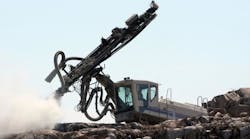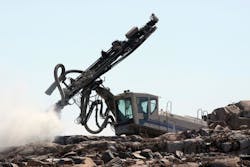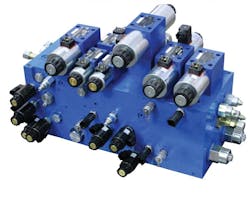Hydraulic integrated circuits (HICs) consist of manifolds and cartridge valves to control hydraulic flow, direction, and pressure in a compact, light weight package that places multiple functions in a convenient centralized location. In addition to compact cartridge valves, the manifold may also house subplate mounted discrete and proportional valves and smaller manifolds containing branch circuits.
Jenna Pringle, of Lynch Fluid Controls Inc., Mississauga, Ont., says HICs also save money by drastically cutting assembly time. Plus, they improve reliability and reduce leakage by eliminating as much as 60% of the hose, tubing, and fittings otherwise required in conventional circuits.
Troubleshooting is another advantage. Pringle offered, “Manifolds are sometimes viewed as a black box, making troubleshooting a concern. However, if a system is properly designed and test points are provided in key locations, troubleshooting becomes much more efficient [because of components’ close proximity to each other].” She also noted that connecting transducers at key locations provides electronic feedback for monitoring, displaying, and analyzing key parameters.
A typical example
Pringle mentioned that HICs are widely used in mining equipment to control rotational speed, direction, torque, and thrust. An example she cited replaced a machine’s original hydraulic system that was inefficient, took up valuable space, and limited its productivity. The machine’s hydraulic system uses a pump rated for maximum flow of 40 gpm at working pressure of 3000 psi (3500 psi intermittently).
Lynch’s Hydraulic Design Team came up with a complete custom integrated hydraulic manifold system. The multifunctional manifold for this application consumes an envelope of 8 × 8 × 20 in. and weighs about 420 lb. It houses seven subplate mounted directional control valves, 29 cartridge valves, and contains 11 work ports and eight test points for gauges and transducers.
The operator uses electronic joysticks to actuate pilot-operated valves that direct high flow and pressure to a rig’s
• feed circuit
• chuck
• foot clamp
• water pump
• wire line, and
• coiler.
The Lynch manifold design allows for simplified troubleshooting and repair by reducing the number of required spare components needed and aiding in ergonomics by placing valves, work ports and test points in more accessible locations.
Pringle said the first implementation was so successful that the customer requested a revised design with additional consolidation of functions. She explained, “Today’s integrated manifold system incorporates three additional functions, 30 cartridge valves, five directional valves and two types of common coils all within the same dimensions of the original (8 × 8 × 20 in.) manifold design. The proportional directional valves have been replaced with cartridge valves, providing uniformity for different functions and changeability down the road. This streamline design allows for flexibility and is currently saving the customer thousands of dollars overall.”
For more information about HICs and smart manifolds, go to www.lynch.ca, or visit Lynch Controls at MINExpo Booth 23073.



